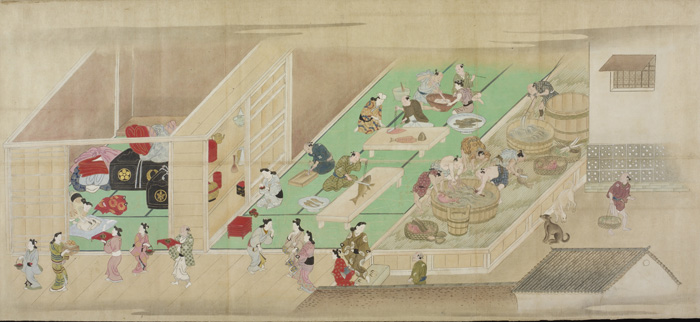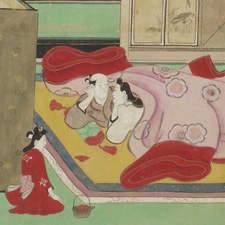'Iron Chef' of 1600s Japan took place in a brothel

LAWRENCE — As University of Kansas researcher Eric C. Rath examined in detail Japanese artist Hishikawa Moronobu's giant painting "A Visit to the Yoshiwara," he noticed the care the artist put in to show chefs in the pleasure quarters of Edo, now Tokyo, working frantically to figure out their next culinary moves.
 "Fantasizing about how the chefs will prepare the ingredients is also part of the enjoyment of Moronobu's painting, an early modern equivalent of the television cooking contest 'Iron Chef,'" said Rath, professor of history, "in which the audience puzzles over the clever ways that chefs compete in preparing unexpected foodstuffs."
"Fantasizing about how the chefs will prepare the ingredients is also part of the enjoyment of Moronobu's painting, an early modern equivalent of the television cooking contest 'Iron Chef,'" said Rath, professor of history, "in which the audience puzzles over the clever ways that chefs compete in preparing unexpected foodstuffs."
In the essay "Sex and Sea Bream," Rath dissects the historical depictions of food and Japanese dietary culture in the painting. The essay is part of the catalog for an ongoing show at the Asian Art Museum in San Francisco.
Moronobu's scroll painting, which was complete in the late 1680s, is about 58 feet long and depicts several scenes of Yoshiwara, which was the city's "pleasure district" at the time, home to government-sanctioned brothels.
The chef's part in the kitchen is integral to the painting, but the work’s historical significance is that it captures gender and equity issues of the period in many ways, Rath said. There was a gross gender imbalance in Edo because samurai warriors, due to feudal obligations, were required to live in the city, and also women from poorer rural families were sent to the brothel out of economic desperation.
Though the setting is an area of prostitution, the depictions of physical sex are hardly graphic, as scenes show couples in bed, though clothed and covered. Most of the romantic details the artist saves for the images of food and cooking.
"The prominence Moronobu gives food in his picture scroll is not coincidental," Rath said. "Dining was a central part of the program of seduction in Yoshiwara."
He details for instance how a man would need to court a woman three times, and the women waiting and serving food were significant as well.
"Food and beverage serving was a common euphemism for the sex trade," Rath said.
The details on the food preparation, though, depict most of the sexuality, as he goes to great lengths to show how cooks will prepare dishes, particularly fish, in many different ways. It's obvious that the food preparation required the most skilled chefs because the area was a major city not only in Japan but the world at the time, Rath said.
Still, he said it's clear the painting points out the gender roles in Japan during the time period — the artist just does it in a clever way.
"Moronobu has provided an elegant record of a lost place, a remembrances of men's pleasures and a subtle criticism of the economic and political flaws that brought women like ingredients to Yoshiwara," Rath said, "transforming them into sustenance for male appetites."
Photo credit: John C. Weber Collection, photo by John Bigelow Taylor.